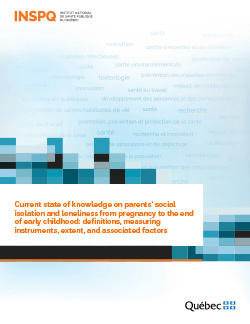Current state of knowledge on parents’ social isolation and loneliness from pregnancy to the end of early childhood: definitions, measuring instruments, extent, and associated factors
This review provides a portrait of our current knowledge on parents’ social isolation and loneliness during the perinatal and early childhood period. This document informs public health actors working with parents and their families on various aspects of these two phenomena. A scoping review was carried out to identify: 1) the definitions of social isolation and loneliness, as well as the distinction with certain related concepts; 2) the main instruments used to measure social isolation and loneliness; 3) the extent of social isolation and loneliness in the population of interest; and 4) the main factors associated with social isolation and loneliness.
The current state of knowledge on social isolation and loneliness during the perinatal and early childhood period is limited. However, this scoping review demonstrates that:
- There is an emerging consensus that social isolation and loneliness are two separate realities. Social isolation is considered an objective parameter that refers to a lack of significant, sustained contact with others, both in quality and quantity. Loneliness, however, is a subjective parameter based on the individual’s perception of a gap between actual and desired social relationships, in terms of quantity and quality. Despite this emerging consensus, some publications addressing both social isolation and loneliness make no formal distinction between these two concepts.
- The UCLA Loneliness Scale is the measuring instrument most commonly used in publications examining social isolation, loneliness, or both in parents during the perinatal and early childhood period. However, no measuring instruments used in population surveys specifically targeting parents, which would make it possible to measure the extent of the phenomenon in this population, were identified in the literature consulted.
- The scientific and grey literatures do not provide for an adequate description of the extent of this phenomenon in parents during the perinatal and early childhood period, as the available data vary significantly.
- There are a wide variety of factors associated with social isolation, loneliness, or both. These factors involve plural aspects of parents’ lives during the perinatal and early childhood period: the characteristics of the individual and the family, and economic, sociocultural, community, societal, and temporal factors.
- Five observations can be made concerning the factors associated with social isolation and loneliness in the literature: 1) the publications mainly focus on identifying the parent’s individual characteristics; 2) there may be multiple and interdependent factors associated with the two phenomena; 3) social isolation and loneliness are phenomena that result from complex systems; 4) both phenomena are associated with certain factors of socioeconomic vulnerability in families; and 5) certain factors associated with social isolation and loneliness are also determinants of parenting.
- The scoping review also allowed us to identify gaps in knowledge, from which we conclude that the phenomena in question merit wider study. A number of subjects related to social isolation and loneliness remain to be explored: prevalence; the influence of new technologies; socioeconomic, cultural, community, and societal factors; the various dimensions of parenting and child development; the father’s experience; effects on socioeconomically vulnerable parents; and strategies to prevent or counter social isolation and loneliness during the perinatal and early childhood period.


